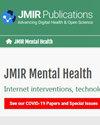Media Use and Its Associations With Paranoia in Schizophrenia and Bipolar Disorder: Ecological Momentary Assessment
IF 4.8
2区 医学
Q1 PSYCHIATRY
引用次数: 0
Abstract
Background: Paranoia is a spectrum of fear-related experiences that spans diagnostic categories and is influenced by social and cognitive factors. The extent to which social media and other types of media use are associated with paranoia remains unclear. Objective: We aimed to examine associations between media use and paranoia at the within- and between-person levels. Methods: Participants were 409 individuals diagnosed with schizophrenia spectrum or bipolar disorder. Measures included sociodemographic and clinical characteristics at baseline, followed by ecological momentary assessments (EMA) collected three times daily over 30 days. EMA evaluated paranoia and five types of media use: social media, television, music, reading or writing, and other internet or computer use. Generalized linear mixed models were used to examine paranoia as a function of each type of media use and vice-versa at the within- and between-person levels. Results: Of the 409 participants, the following subgroups reported at least one instance of media use: 261 (63.8%) for using social media, 385 (94.1%) for watching TV, 292 (71.4%) for listening to music, 191 (46.7%) for reading or writing, and 280 (68.5%) for other internet or computer use. Gender, ethnoracial groups, educational attainment, and diagnosis of schizophrenia vs. bipolar disorder were differentially associated with the likelihood of media use. There was a within-person association between social media use and paranoia: using social media was associated with a subsequent decrease in paranoia of 5.5% (fold-change=0.945; 95% CI: 0.904, 0.987). The reverse association, from paranoia to subsequent changes in social media use, was not statistically significant. Other types of media use were not significantly associated with paranoia. Conclusions: This study found that social media use was associated with a modest decrease in paranoia, perhaps reflecting clinical benefits of social connection. However, structural disadvantage and individual factors may hamper the accessibility of media activities, and the mental health correlates of media use may further vary as a function of contents and contexts of use.媒体使用及其与精神分裂症和躁狂症偏执狂的关系:生态学瞬间评估
背景:妄想症是一系列与恐惧相关的体验,跨越诊断类别,并受到社会和认知因素的影响。社交媒体和其他类型媒体的使用在多大程度上与偏执狂有关,目前仍不清楚。研究目的我们旨在研究媒体使用与妄想症在人内和人际层面上的关联。研究方法研究对象为 409 名被诊断为精神分裂症谱系或躁郁症的患者。测量指标包括基线时的社会人口学特征和临床特征,以及在 30 天内每天收集三次的生态瞬间评估(EMA)。EMA 评估了偏执狂和五种媒体使用情况:社交媒体、电视、音乐、阅读或写作以及其他互联网或计算机使用情况。我们使用广义线性混合模型来研究妄想症与每种媒体使用类型的函数关系,反之亦然。研究结果在 409 名参与者中,以下分组报告了至少一次媒体使用情况:261人(63.8%)使用社交媒体,385人(94.1%)看电视,292人(71.4%)听音乐,191人(46.7%)阅读或写作,280人(68.5%)使用其他互联网或电脑。性别、种族、教育程度、精神分裂症诊断与双相情感障碍诊断与使用媒体的可能性有不同的关联。社交媒体的使用与妄想症之间存在个人内部联系:使用社交媒体与随后妄想症减少 5.5% 相关(折叠变化=0.945;95% CI:0.904,0.987)。从偏执狂到随后社交媒体使用变化的反向关联在统计学上并不显著。其他类型的媒体使用与妄想症没有明显关联。结论本研究发现,社交媒体的使用与妄想症的适度减少有关,这或许反映了社交联系的临床益处。然而,结构上的不利因素和个人因素可能会妨碍媒体活动的可及性,媒体使用的心理健康相关因素可能会因使用内容和环境的不同而进一步变化。
本文章由计算机程序翻译,如有差异,请以英文原文为准。
求助全文
约1分钟内获得全文
求助全文
来源期刊

Jmir Mental Health
Medicine-Psychiatry and Mental Health
CiteScore
10.80
自引率
3.80%
发文量
104
审稿时长
16 weeks
期刊介绍:
JMIR Mental Health (JMH, ISSN 2368-7959) is a PubMed-indexed, peer-reviewed sister journal of JMIR, the leading eHealth journal (Impact Factor 2016: 5.175).
JMIR Mental Health focusses on digital health and Internet interventions, technologies and electronic innovations (software and hardware) for mental health, addictions, online counselling and behaviour change. This includes formative evaluation and system descriptions, theoretical papers, review papers, viewpoint/vision papers, and rigorous evaluations.
 求助内容:
求助内容: 应助结果提醒方式:
应助结果提醒方式:


